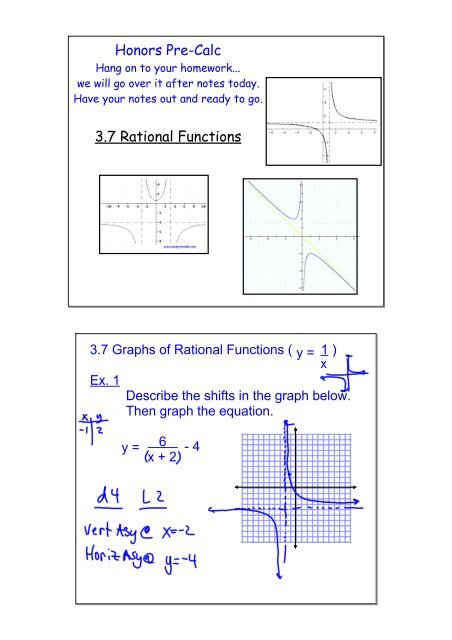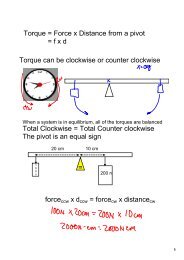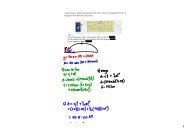Honors Pre-Calc 3.7 Rational Functions
Honors Pre-Calc 3.7 Rational Functions
Honors Pre-Calc 3.7 Rational Functions
Create successful ePaper yourself
Turn your PDF publications into a flip-book with our unique Google optimized e-Paper software.
<strong>Honors</strong> <strong>Pre</strong>-<strong>Calc</strong>Hang on to your homework...we will go over it after notes today.Have your notes out and ready to go.<strong>3.7</strong> <strong>Rational</strong> <strong>Functions</strong><strong>3.7</strong> Graphs of <strong>Rational</strong> <strong>Functions</strong> ( y = 1 )xEx. 1Describe the shifts in the graph below.Then graph the equation.y =6x + 2 4
Guidelines for finding asymptotes of rational functions:if the numerator and denominator have common factors,factor them out (these become points of discontinuity)the zeros of the denominator are vertical asymptotesdegree of numerator (n) and degree of denominator (d)if n < d, then y = 0 is a horizontal asymptoteif n = d, then the leading coefficients create thefraction that is the horizontal asymptoteif n > d, then there is no horizontal asymptoteif n > d BY ONE, then there is a slant asymptote andyou must use polynomial division to determinethe equation of the line.Ex. 2 Find the horizontal and verticalasymptotes. Then graph the equation.g(x) = 1x + 5
Ex. 3 Find the horizontal, vertical, and slantasymptotes (if any). Then graph the equation.Ex. 4 Find the horizontal, vertical, and slantasymptotes (if any). Then graph the equation.f(x) = 2x 2 3x + 1x 2
















